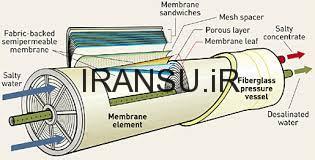فنآوری غشائی
در دههی گذشته، فنآوری غشائی به یک فنآوری جداسازی برتر تبدیل شده است. نیروی اصلی در فنآوری غشائی واقعیتی است که بدون افزودن مواد شیمیایی، با استفاده از انرژی نسبتاً کم و بهسهولت و نیز با استفاده از فرآیندهای جریانی با چیدمان خوب، عمل میکند.
فنآوری غشائی یک اصطلاح عمومی است که برای تعدادی از فرآیندهای جداسازی مختلف و بسیار مشخص بهکار میرود. این فرآیندها از یک نوع هستند، زیرا در هر یک از آنها از یک غشاء استفاده شده است. غشاءها معمولاً برای تولید آب فرآیند از آبهای زیرزمینی، آبهای سطحی و یا فاضلاب، بسیار مورد استفاده قرار میگیرند. در حال حاضر برای روش ممبرینهاهای معمولی با هم رقابت میکنند. فرآیند جداسازی غشائی مبتنی بر وجود ممبرینهای نیمه تراوا میباشد.
این قاعده کلی کاملاً ساده است: غشا به عنوان یک فیلتر بسیار خاص عمل میکند که به آب اجازهی عبور میدهد، در حالیکه جامدات معلق و مواد دیگر را نگه میدارد.
روشهای مختلفی برای ایجاد توانایی در مواد جهت نفوذ پیدا کردن به داخل غشاء وجود دارد. نمونههایی از این روشها عبارتند از بهکار بردن فشار بالا، حفظ شیب غلظت در دو طرف غشاء و ایجاد پتانسیل الکتریکی.
ممبرینها از یک دیواره با خاصیت جداسازی انتخابی استفاده میکنند. مواد مشخصی میتوانند از طریق غشاء عبور کنند، در حالیکه مواد دیگر قادر به عبور نیستند.
فیلتراسیون غشایی میتواند بهعنوان جایگزینی برای لختهسازی، روشهای تصفیه رسوبی، جذبی (فیلترهای شنی و فیلترهای کربن فعال، مبدلهای یون)، استخراج و تقطیر استفاده شود.
دو عامل وجود دارد که مقدار تأثیر فرآیند فیلتراسیون غشایی را تعیین میکند. قابلیت گزینش (selectivity) و مقدار بهرهوری(productivity) . قابلیت گزینش پارامتری است که عامل نگهداشتن یا جداسازی نیز نامیده میشود. مقدار بهرهوری نیز پارامتری است که شدت نفوذ نامیده میشود (بر حسب واحد l/m2.h بیان میگردد). قابلیت گزینش و مقدار بهرهوری به ممبرین بستگی دارند.
Membrane Technology
In the past decade, membrane technology has become a preferred isolation technology. In fact that is the main force of membrane technology without adding chemicals, using relatively little energy and using processes Bhs·hvlt good flow with the order acts.
Membrane technology is a general term for a number of different and very distinct separation processes used. These processes are of the same type, for each of which a membrane is used. Membranes commonly used for the production of process water from groundwater, surface water or wastewater is used. We membrane to compete with conventional methods. Mmbrynhay semi-permeable membrane separation process is based there.
The principle is quite simple: the membrane acts as a very specific filter that allow water to pass, while keeping suspended solids and other materials.
Several ways to create a material’s ability to penetrate into the membrane to find there. Examples of these methods include the use of high pressure, maintaining a concentration gradient on both sides of the membrane electrical potential.
Membrane of a wall separating the property of their choice. Certain substances can pass through the membrane while other substances are able to pass.
Membrane filtration as an alternative to clotting, sediment treatment methods, adsorption (sand filters and activated carbon filters, ion exchange), extraction and distillation is used.
There are two factors that determine the effect of membrane filtration process. Feature selection (selectivity) and the efficiency (productivity). Feature selection is a parameter called the retention or separation. Productivity is the value of a parameter called flux (in units of l / m2.h expressed). Feature selection and value depend on the efficiency of the membrane.
Zyrzmyny, water purification methods Rsvby, Alktryky, potential separation process technology Ghshayy, Jryany, Ghshayy, filtration processes Ghshayy, carbon filters Fal, Lkhthsazy, Mmbrynha, Mmbrynhay semipermeable


